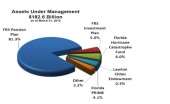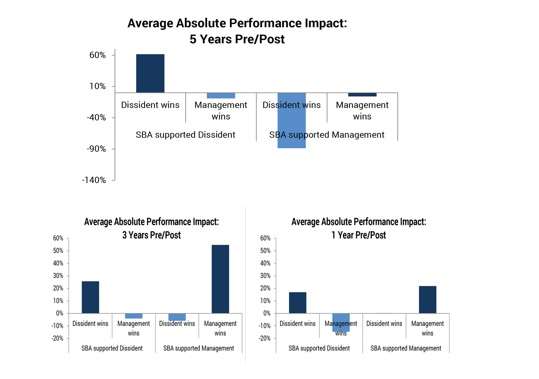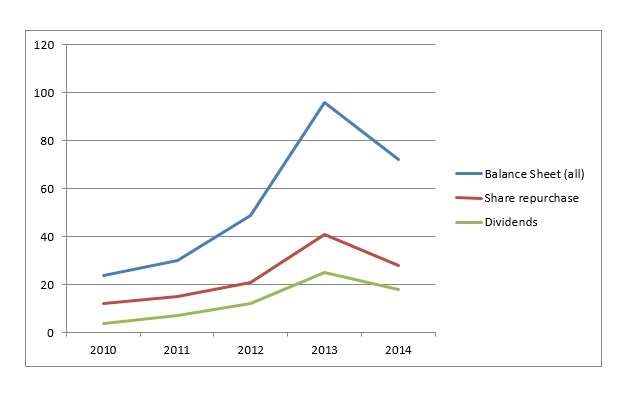 Florida’s State Board of Administration, the manager of the assets of the Florida Retirement System Pension Plan, has a long record of engagement with the managers of the corporations in which it has invested those assets, and it has of necessity made a lot of proxy voting decisions. In 2014, Activist Insight named the SBA the top institutional investor in voting to support dissident slates in proxy contests.
Florida’s State Board of Administration, the manager of the assets of the Florida Retirement System Pension Plan, has a long record of engagement with the managers of the corporations in which it has invested those assets, and it has of necessity made a lot of proxy voting decisions. In 2014, Activist Insight named the SBA the top institutional investor in voting to support dissident slates in proxy contests.
In June 2015, the SBA released a report looking at the consequences of those voting decisions. This sounds like a straightforward, routine, common-sense sort of thing to do. When an institution routinely engages in a certain behavior, it stands to reason that it should look back now-and-then and decide for itself how that behavior has worked out for its ultimate goals (such as keeping safe the money due to pensioners present and future).
What is surprising is that this sort of study isn’t routine. To the contrary, the Harvard Law School Forum on Corporate Governance has called this a “first of its kind” [!] empirical analysis for an institutional investor.
I suppose the SBA, then, gets credit for shattering the glass ceiling that separates actual institutional behavior from common sense. Let’s hope that barrier remains shattered, empirical evidence on that general subject notwithstanding.
Truth and Consequences
The SBA study found that it had supported “one or more dissident board candidates 65% of the time” between 2006 and 2014 inclusive. It looked at the cumulative stock performance of the companies involved in three different time frames after that vote: one, three, and five years. Where the SBA supported the dissident but the management won all seats nonetheless, the cumulative stock performance of the companies involved was negative in each of these time frames, -14%, -16%, and -15% respectively.

Source: Florida SBA Report, p. 15.
As the above graphs indicate, the results when the SBA supported one or more victorious dissidents were positive in each time frame, and they were more positive for the longest of those frames.
How the Analysis Works
The results when the SBA supported management and management won were mixed: positive both one and three years out, negative five years out.
The patterns are much the same whether one measures in absolute terms (as in the graphs above) or in industry-relative terms.
The authors of the study see these numbers as supporting the analytical framework that the SBA employs in determining how to vote in the case of such a contest. Specifically, when a dissident win would amount to a take-over, the SBA analysis asks: (1) have dissidents demonstrated the need for change at the company? and (2) will the dissidents be in a better position to effect the necessary change? They look for a “well-reasoned and detailed business plan” from the dissidents, including “strategic initiatives, a transition plan that describes how the dissidents will effect change in control, and the identification of a qualified and credible new management team.”
When on the other hand the challenge if successful will result only in minority board representation, there is a lower “burden of proof” on the dissidents. The analysis requires only proof that the dissident slate “will add value to board deliberations, including by considering the issues from a viewpoint different than current management.”
Again, this sounds like common sense. But, again, it isn’t especially common.
Fads in Proxy Fights
One incidental revelation of the study is the degree to which particular sorts of activist campaign cluster together. They come and go like this year’s fashions.
Consider balance-sheet activism, that is, campaigns aimed at getting a management to repurchase shares, issue dividends, sell assets or the like. The frequency of such campaigns steadily increased from 2010 until 2013, and then sharply fell in 2014. This year’s results aren’t in yet of course, but it seems that the balance-sheet activist ‘moment’ may simply have come and gone.
The graph below gives this tidal motion in visual form, both for the over-all numbers on balance-sheet activism within the SBA database and for the two most common sorts thereof. 
Source: Adapted from Florida SBA Report, Table, p. 20



